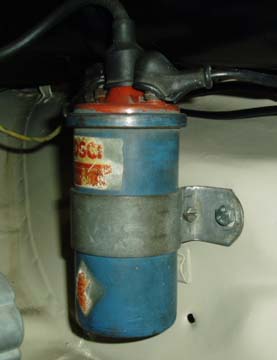
Overview, and advantage to having a "hotter" spark
Ignition Coil Theory
When you turn on the ignition switch of your Mercedes-Benz Ponton, battery current flows to the coil. The coil actually consists of two coils of wire: one fairly heavy wire, the other of fine wire. The secondary fine wire circuit is wound over the primary heavy wire circuit, but the two circuits are insulated from each other.

Photo 1. Ignition coil mounted in the engine bay of a Mercedes-Benz Ponton — near the distributor
As long as electrical current is flowing steadily through the primary circuit, there is no effect in the secondary circuit. But when primary current flow stops suddenly, as when the distributor breaker points open, a momentary high voltage is created in the secondary wires. It is caused by the rapidly collapsing magnetic field cutting across the many secondary wires. The voltage produced by this action is more than enough to jump across the spark plug gaps.
Replacing or "Upgrading" the Coil
There are on the market several ignition coils known variously as "sports" or high voltage types. They are designed to supply their output at about 25 to 33 percent higher voltage than the standard article, thus enabling wider spark plug gaps to be used if desired, and providing a hotter spark even across the normal gap.
It will be of interest at this juncture to comment, in the light of practical experience, on statements which have been made from time to time, to the effect that so long as the spark will jump the plug gap (at its correct setting) and the engine starts and performs satisfactorily throughout its rev/min range, there can be no advantage in so-called "hotter" sparks. The author's experience simply concerns an engine which did all these things, but on which, purely as an experiment, the magneto was changed for another instrument which was known to be of an improved pattern. It should be emphasized that in effecting the change, nothing was disturbed, in fact the plugs were not even removed from the cylinders, and there was no alteration of timing.
The result of the change was that a hill previously requiring third gear was easily surmounted in top. Obviously there could be only one explanation for this - more effective firing of the mixture, even with the same plug gap, timing of spark, and volume of mixture inhaled. And this could only be due to a more effective spark.
The higher voltage of these special coils (and the same remark applies to modern coils designed to replace standard coils) calls for some care in the arrangement of the high-tension wiring. It will be appreciated that increased voltage means more liability to leakage of current, and there is little doubt that in production engines the voltage is held down to a figure which, whilst ensuring a satisfactory spark, will not cause undue leakage even when the current-carrying parts are covered with oily filth and moisture.
The use of wide plug gaps will, of course, encourage any leakage and the gap recommended by the coil maker should not be exceeded. It may be found in fact that a gap somewhere between that used with the normal coil and that specified for the "special" will give the most satisfactory results.
Low-Tension Matters
The extra coil output naturally calls for more low-tension current to be dealt with by the contact-breaker points. Some makers of high voltage coils market toughened points and more robustly insulated condensers for use with their product, and these should certainly be included in any change over. Otherwise, the low-tension side does not call for any particular attention since, of course, the voltage remains as before.
After all this, the reader will want to know whether the expense (time, money, effort) is worthwhile. The answer depends very largely on the type of ignition system fitted as standard. Power increases obtained by using wide-gap plugs (whether as standard or as the result of a "high-voltage" modification) are felt generally at high revolutions. Drivers who are not particularly interested in more power at this point may be unimpressed since, if the accent is on top-gear cruising rather than quickness in the intermediate gears, the standard parts will probably by adequate.
References / Acknowledgements
- How to Service and Repair Your Own Car / © 1973, Richard Day / Library of Congress Catalog Card Number: 72-97173 / SBN: 06-011003-1. There was no ISBN, only an SBN.
- Tuning for Economy and Performance / © 1977, Philip H. Smith / Coles Publishing, Toronto. No identification number
- Photo of Bosch coil courtesy: Chris Macha / 1960 Mercedes-Benz Type W121 190b Ponton sedan